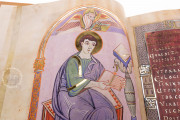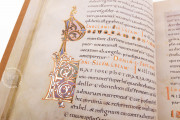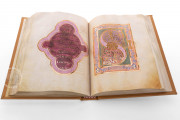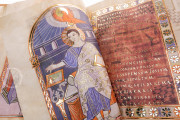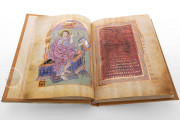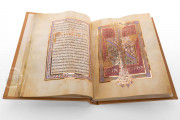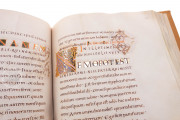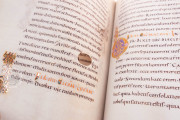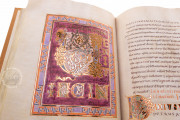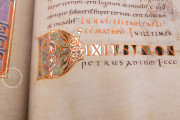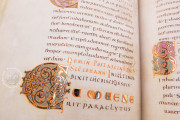A masterwork of early Ottonian manuscript illumination, the Gero Codex is a Christian liturgical book of readings from the Gospels to be intoned at Mass. Made at Reichenau before 969, it owes its nickname to its patron, Gero, future archbishop of Cologne, who is pictured receiving the book from the scribe Anno and presenting it to Saint Peter. The illumination includes seven full-page miniatures: two dedication miniatures, portraits of the four authors of the Gospel accounts of the life of Christ, and Christ in Majesty. Fourteen pages with painted purple grounds feature gold writing or a large interlace initial.
The Gero Codex stands near the beginning of a long artistic tradition. The island monastery of Reichenau, where it was created, would continue for generations to dominate the production of deluxe illuminated manuscripts—many of them made for members of the Ottonian imperial family.
A Carolingian Model
The manuscript's author portraits of Saints Matthew, Mark, Luke, and John (fols. 1v, 2v, 3v, and 4v) and the Christ in Majesty image (fol. 5v) were directly inspired by the same subjects in the Lorsch Gospels, a deluxe manuscript made 150 years earlier for a member of the Carolingian imperial family. A single prominent, seated figure dominates each miniature.
The Ottonian artist copied the enormous golden halos from his Carolingian predecessor's portraits and transformed the drapery patterns and highlights into dizzying patterns that make the figures seem even more ethereal. The Gospels' authors are unquestionably divinely inspired by their symbols, pictured in the arches above them.
Dedication to Saint Peter
The first dedication miniature depicts the tonsured Gero presenting the book to the imposing figure of Saint Peter (fol. 6v). The enthroned saint blesses the smaller Gero, who holds up the manuscript, rendered like the nearby architectural decoration in gold and silver. The facing inscription characterizes Peter as gatekeeper of heaven and prince of the Church and the gold and silver book as a "little book" (fol. 7r).
Anno and His Patron
In the second dedication miniature, the scribe Anno presents the gold and silver volume to the enthroned Gero—in this case, the larger of the two figures (fol. 7v). The golden inscription on the facing page addresses Gero directly, calling him the blessed custos (guardian) of the basilica of Saint Peter, a reference to his role at the cathedral at Cologne (fol. 8r).
Full-Page Text Panels
Each miniature appears on a left-hand page opposite a framed nine-line poem written in gold Rustic Capitals. Those for the evangelist portraits offer characterizations of the author's particular account of the life of Christ and allude to each author's symbol: Matthew/man, Mark/lion, Luke/calf, and John/eagle.
Characteristic Ottonian Initials
Anno wrote the main text in a large, clear Caroline Minuscule script in long lines (one column). Each Gospel pericope (excerpt) is introduced by a decorated initial composed of golden interlaced leafy vines with curling silver branches filling the letters. The vines are outlined in orange red against backgrounds of blue, green, mauve, and burgundy.
The initials for the vigil of Christmas, Christmas, Pentecost, and the feast of Saint Peter are set into framed, fully painted incipit pages. The initial for Easter, also on a fully painted page, is historiated: it shows the Women at the Tomb (fol. 86r).
An Acknowledged Treasure
The remarkable Christ in Majesty (fol. 5v) inspired the painters of the Petershausen Sacramentary (Heidelberg, Universitätasbibliothek Heidelberg, Cod. Sal. IXb), made at Reichenau about ten years after the Gero Codex. At the dissolution of the Premonstratensian monastery of Saint Lawrence, Wedinghausen, in 1803, the Gero manuscript was transferred to Darmstadt. As one of "the illuminated manuscripts of the Ottonian period produced at Reichenau," the manuscript entered UNESCO's Memory of the World Register in 2003.
We have 1 facsimile edition of the manuscript "Gero Codex": Gero Codex (Codice di Gerone) facsimile edition, published by Imago, 2021
Request Info / Price

